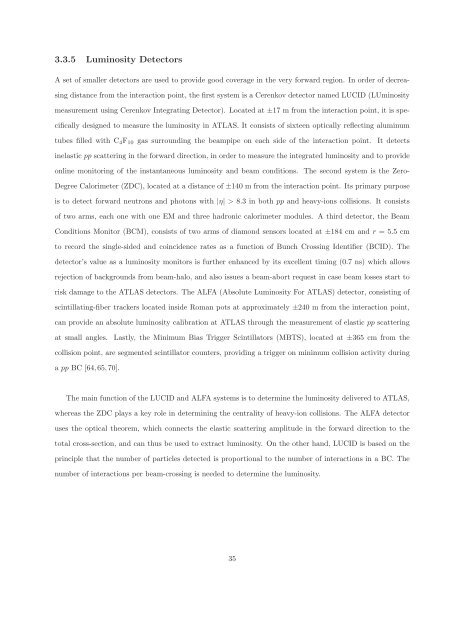CERN-THESIS-2012-153 26/07/2012 - CERN Document Server
CERN-THESIS-2012-153 26/07/2012 - CERN Document Server
CERN-THESIS-2012-153 26/07/2012 - CERN Document Server
You also want an ePaper? Increase the reach of your titles
YUMPU automatically turns print PDFs into web optimized ePapers that Google loves.
3.3.5 Luminosity Detectors<br />
A set of smaller detectors are used to provide good coverage in the very forward region. In order of decrea-<br />
sing distance from the interaction point, the first system is a Cerenkov detector named LUCID (LUminosity<br />
measurement using Cerenkov Integrating Detector). Located at ±17 m from the interaction point, it is spe-<br />
cifically designed to measure the luminosity in ATLAS. It consists of sixteen optically reflecting aluminum<br />
tubes filled with C4F10 gas surrounding the beampipe on each side of the interaction point. It detects<br />
inelastic pp scattering in the forward direction, in order to measure the integrated luminosity and to provide<br />
online monitoring of the instantaneous luminosity and beam conditions. The second system is the Zero-<br />
Degree Calorimeter (ZDC), located at a distance of ±140 m from the interaction point. Its primary purpose<br />
is to detect forward neutrons and photons with |η| > 8.3 in both pp and heavy-ions collisions. It consists<br />
of two arms, each one with one EM and three hadronic calorimeter modules. A third detector, the Beam<br />
Conditions Monitor (BCM), consists of two arms of diamond sensors located at ±184 cm and r = 5.5 cm<br />
to record the single-sided and coincidence rates as a function of Bunch Crossing Identifier (BCID). The<br />
detector’s value as a luminosity monitors is further enhanced by its excellent timing (0.7 ns) which allows<br />
rejection of backgrounds from beam-halo, and also issues a beam-abort request in case beam losses start to<br />
risk damage to the ATLAS detectors. The ALFA (Absolute Luminosity For ATLAS) detector, consisting of<br />
scintillating-fiber trackers located inside Roman pots at approximately ±240 m from the interaction point,<br />
can provide an absolute luminosity calibration at ATLAS through the measurement of elastic pp scattering<br />
at small angles. Lastly, the Minimum Bias Trigger Scintillators (MBTS), located at ±365 cm from the<br />
collision point, are segmented scintillator counters, providing a trigger on minimum collision activity during<br />
a pp BC [64,65,70].<br />
The main function of the LUCID and ALFA systems is to determine the luminosity delivered to ATLAS,<br />
whereas the ZDC plays a key role in determining the centrality of heavy-ion collisions. The ALFA detector<br />
uses the optical theorem, which connects the elastic scattering amplitude in the forward direction to the<br />
total cross-section, and can thus be used to extract luminosity. On the other hand, LUCID is based on the<br />
principle that the number of particles detected is proportional to the number of interactions in a BC. The<br />
number of interactions per beam-crossing is needed to determine the luminosity.<br />
35















